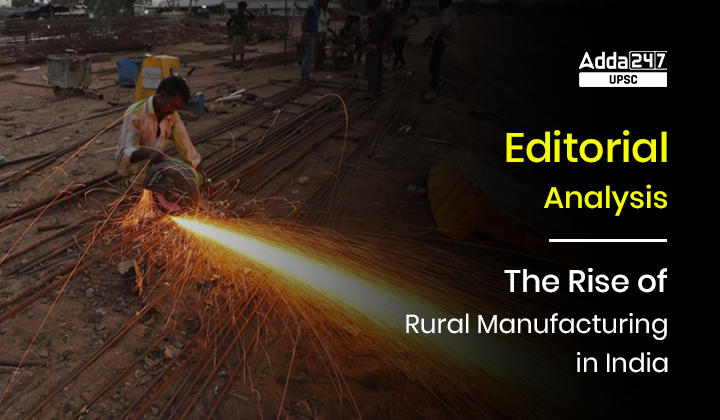Table of Contents
Relevance of Today’s Editorial for UPSC
Rising Rural Manufacturing in India: This topic the Rise of Rural Manufacturing in India covers GS 2: Government policies and interventions for development of various sectors and issues arising out of it.
What is the Issue of Today’s Editorial?
- There are evidences through research which suggest that the manufacturing activity and employment has been rapidly shifting from bigger cities to smaller towns and rural areas.
- Experts call this ‘urban-rural manufacturing shift’ and interpret it as mixed bag, as it has its share of advantages that could transform the rural economy, as well as a set of constraints, which could hamper higher growth.
Background
The movement of manufacturing away from urban locations was brought out by the Work Bank in a report a decade ago .
Also Read:
India’s Manufacturing Purchasing Managers’ Index (PMI)
Is India’s Manufacturing Sector Moving Away from Cities?
Formal vs Informal Sector:
- The study named Policy Research Working Paper, World Bank investigated the urbanisation of the Indian manufacturing sector by “combining enterprise data from formal and informal sectors and found that manufacturing plants in the formal sector are moving away from urban areas and into rural locations, while the informal sector is moving from rural to urban locations”.
- Their results suggested that higher urban-rural cost ratios caused this shift.
Rural Sector is dominating:
- Recent data from the Annual Survey of Industries for 2019-20, shows that the rural segment is a significant contributor to the manufacturing sector’s output.
- While 42% of factories are in rural areas, 62% of fixed capital is in the rural side.
- This is the result of a steady stream of investments in rural locations over the last two decades.
- In terms of output and value addition, rural factories contributed to exactly half of the total sector.
- In terms of employment, it accounted for 44%, but had only a 41% share in the total wages of the sector.
Also Read:
Kurukshetra Magazine (August 2022): Initiatives To Promote Rural Industrialization
What are the reasons of this Urban to Rural shift in manufacturing?
- Studies have documented several causes for the relatively steady rise and presence of rural manufacturing.
- Rural areas have generally been more attractive to manufacturing firms because wages, property, and land costs are all lower than in most metropolitan areas.
- Broadly there could be three explanations for this shift of manufacturing away from urban locations.
- First is the factory floorspace supply constraints: In cities, factories just cannot be expanded as opposed to rural areas. Thus, increased capital intensity of production is one reason for this trend.
- Second is production cost differentials: Many firms experience substantially higher operating costs in cities than in rural areas, with inevitable consequences for the firm’s profitability and competitiveness.
- The third is the possibility of capital restructuring: Big firms deliberately shift production from cities to take advantage of the availability of less skilled, less unionised and less costly rural labour.
Key Benefits of Rising Rural Manufacturing in India
- Rising Rural Manufacturing helped maintain the importance of manufacturing as a source of livelihood diversification in rural India.
- Manufacturers finding cheaper methods and locations of production.
- The growth of rural manufacturing, by generating new jobs, thus provides an economic base for the transition out of agriculture.
Which are the Challenges ahead?
The shift towards rural manufacturing faces two major challenges.
Higher Cost of Capital
- Though firms reap the benefits of lower costs via lower rents, the cost of capital seems to be higher for firms operating on the rural side.
- This is evident from the shares in rent and interest paid. The rural segment accounted for only 35% of the total rent paid, while it had 60% of the total interest payments.
- So, the benefits reaped from one source seem to be off set by the increased costs on the other front.
Skills shortage
- There exists an issue of “skills shortage” in rural areas as manufacturing now needs higher skilled workers to compete in the highly technological global ‘new economy’.
- Manufacturers who depend only on low wage workers simply cannot sustain their competitive edge for longer periods as this cost advantage vanishes over time.
Conclusion
Given the size of the Indian economy and the need for balanced regional development, the dispersal of manufacturing activities from Urban to Rural areas is a welcome sign. However, more advance skilling of Rural youth will definitely be a game changer to make India a Global Manufacturing hub.
You may also find these Useful:
(Recent Editorial Analysis by our team at Adda247)




 TSPSC Group 1 Question Paper 2024, Downl...
TSPSC Group 1 Question Paper 2024, Downl...
 TSPSC Group 1 Answer key 2024 Out, Downl...
TSPSC Group 1 Answer key 2024 Out, Downl...
 UPSC Prelims 2024 Question Paper, Downlo...
UPSC Prelims 2024 Question Paper, Downlo...
